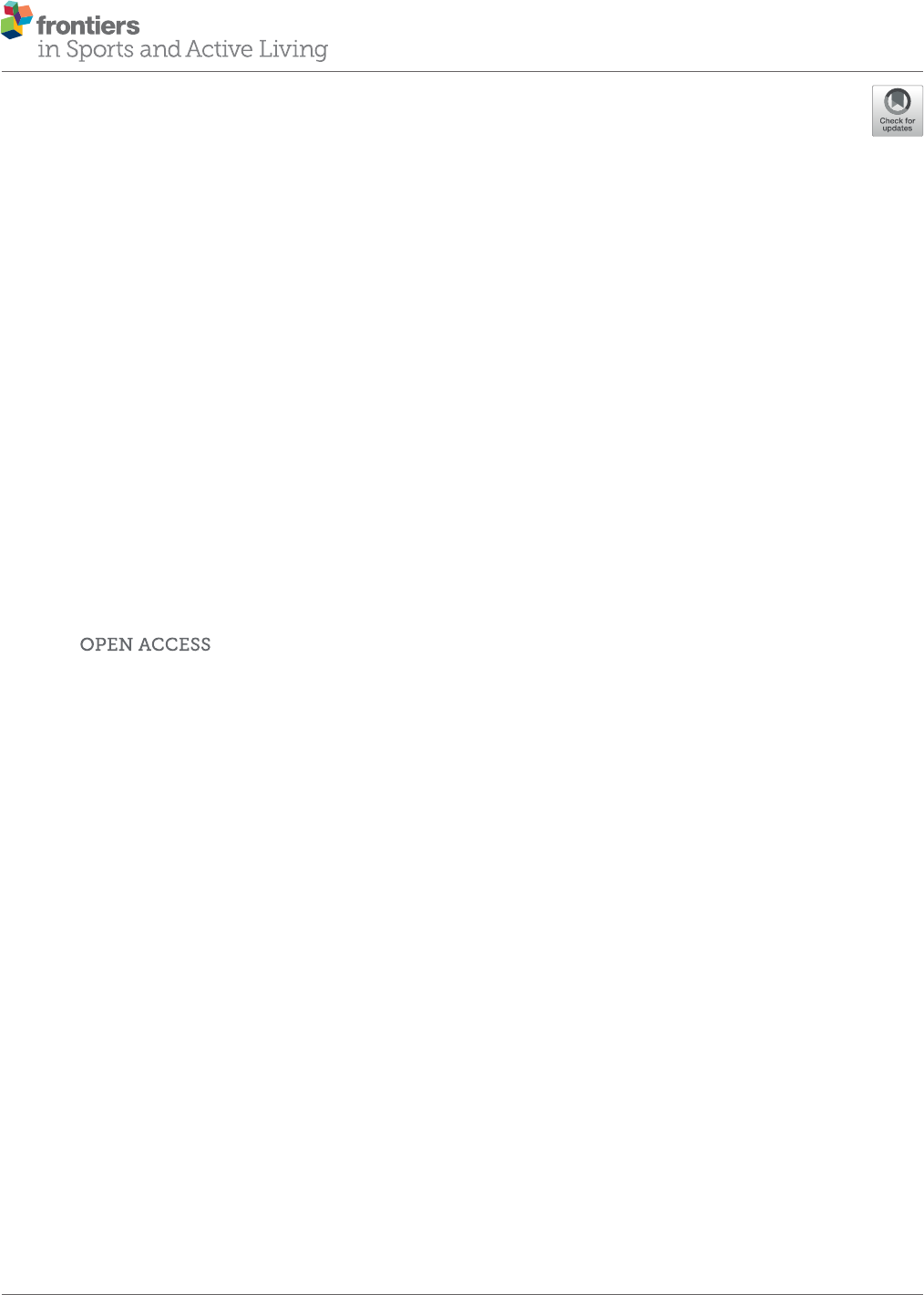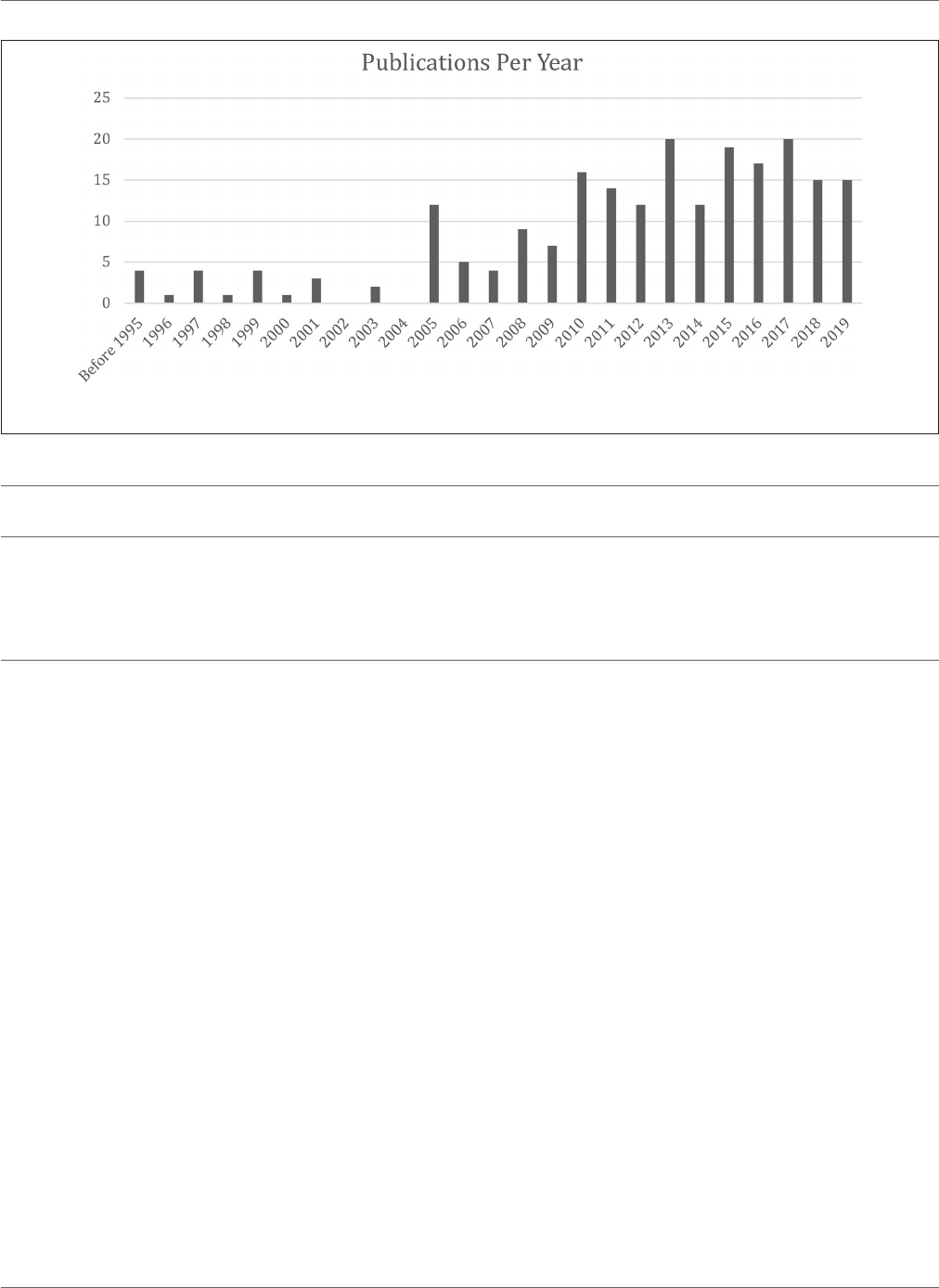
REVIEW
published: 28 January 2022
doi: 10.3389/fspor.2022.812200
Frontiers in Sports and Active Living | www.frontiersin.org 1 January 2022 | Volume 4 | Article 812200
Edited by:
Eric C. Schwarz,
Victoria University, Australia
Reviewed by:
Thomas Fletcher,
Leeds Beckett University,
United Kingdom
Marianne Clark,
University of New South
Wales, Australia
*Correspondence:
Kerri Bodin
Specialty section:
This article was submitted to
Sports Management, Marketing and
Business,
a section of the journal
Frontiers in Sports and Active Living
Received: 09 November 2021
Accepted: 05 January 2022
Published: 28 January 2022
Citation:
Bodin K, Teare G and Taks M (2022)
Critical Social Science in Sport
Management Research: A Scoping
Review.
Front. Sports Act. Living 4:812200.
doi: 10.3389/fspor.2022.812200
Critical Social Science in Sport
Management Research: A Scoping
Review
Kerri Bodin
*
, Georgia Teare and Marijke Taks
Faculty of Health Sciences, School of Human Kinetics, University of Ottawa, Ottawa, ON, Canada
Sport management scholars have called for the application of broader research
approaches, including crit ica l social science. Such approaches help uncover the
less-desirable aspects of sport and, therefore, offer a basis for positive change. While
there have been adva ncements in the use of innovative research approaches over time,
there remains little understanding of how these calls have been addressed. The purpose
of this scoping review is to examine trends, gaps, and the use of critical social science and
associated approaches in sport management scholarship. Two hundred sixteen relevant
articles were identified through a database search (i.e., five platforms), complemented
with a manual search of 419 journals. Results indicate that an increase in critical research
published in sport management journals was evident following 2005. Findings suggest
that there remains space for increased publication of critical social science work in sport
management journals and for researchers to better articulate their research approaches
in scholarly outputs.
Keywords: philosophical paradigms, research approach, state of the field, theoretical contribution, systematic
reviewing
INTRODUCTION
In the past two decades, scholars have increasingly called for sport management researchers to
include more critical social science i n their work (
Amis and Silk, 2005; Skinner and Edwards, 2005;
Chalip, 2006). Notably, in Frisby’s (2005) Zeigler Award address, a prestigious award offered by
the North American Society of Sport Management (NASSM), the use and applicability of critical
approaches to advance the sport management field was highlighted. Frisby (2005) stated that
critical approaches to sport management research would help to illuminate the “ugly” sides of sport
management in hopes of informing change to improve practice. Similarly, in the introduction to a
special issue on critical reflection in sport management,
Amis and Silk (2005) acknowledged that
while sport management journals published a variety of research approaches, perspectives, and
theories, there was still much to unpack regarding the philosophical and political backbone of work
in the field. Critical approaches are heavily employed in sport sociology, and s cholars have further
suggested that drawing on critical sociologic al perspectives in sport management can strengthen
the field and our understanding of power in s port organizations (Knoppers, 2015). Alongside such
calls for the use of more diverse research approaches, scholars have recently employed a variety of
paradigmatic, methodological, and theoretical strategies in their work (e.g., McSweeney and Faust,
2019
). For this study, we focus on critical social science, which is “a way of empowering individuals
by confronting injustices in order to promote social change” (Frisby, 2005, p. 2). This includes
a variety of theories (e.g., critical theory;
Kincheloe and McLaren, 2011) and associated research

Bodin et al. Critical Social Science in Sport Management
approaches (e.g., participatory action research). Critical research
approaches, and articulating such approaches clearly, help to
unpack systemic issues within social spheres, and therefore
offer new insight into areas that need improvement. Critical
approaches typically offer the opportunity to investigate power
structures within taken-for-granted systems and provide
researchers with the tools for understanding how and why
systems may be exclusive, oppressive, or otherwise need
improvement (Knoppers, 2015; Sveinson et al., 2021). In sport
specifically, this is important for practice to determine how
to best provide programming and sport resources to as many
people as possible.
Research has expanded beyond post-positivist approaches
and has begun to explore various lenses through which sport
management topics can be understood. One of many possible
examples includes Singer’s (2005) call for t he use of critical
race theory to address issues of race and ethnicity in sport.
More recently,
Chen and Mason (2019) made similar suggestions
for decentering colonial perspectives and employing settler
colonialism in research. Critical realist a pproaches to policy and
management have also been brought forth as ways to incorporate
broader perspectives in sport research more generally, and
therefore offering a way to advance social justice objectives
(Downward, 2005). These critical paradigms have offered
significant advancement in understanding different points of
view and have added the value of different research perspectives
in th e field.
With the addition and increase in the use of critical,
interpretive, and constructivist paradigms, qualitative research
methodologies have also increased in use. However, there
remains work to be done in advancing these methods
(
Singer et al., 2019). Methodological approaches such as
autoethnography (Hoeber and Kerwin, 2013; Cooper et al., 2017)
and participatory action research (Frisby et al., 2005; Shaw and
Hoeber, 2016; Hoeber and Shaw, 2017) are particularly valuable
for critical social science. Most recently, Sveinson et al. (2021)
have advocated for increased use of critical discourse analysis
as a theory, methodology, and analysis in sport management
scholarship. These methods engage diverse perspectives wit h a
particular focus on advancing equity within sport, an important
component of critical social science and associated research
approaches. Further, upon investigating additional ontological
and epistemologic al approaches,
Quatman and Chelladurai
(2008) advanced social network analysis as an avenue through
which to address Frisby’s (2005) c a ll for advancing critical
social science and associated research approaches. Alongside
the increase in qualitative methodologies, mixed methods have
begun to gain traction in recent years, as researchers have
acknowledged the benefits of drawing upon diverse research
methods in individual projects (van der Roest et al., 2015).
Theoretically, scholars have sought to expand existing sport
management research practices by introducing new theory
and integrating theory from other fields into the management
space (e. g., Sotiriadou and Shilbury, 2010; Kitchin and Howe,
2013
). Each of these trends have advanced understanding of
sport studies and sport management and have offered enriched
perspectives regarding how to improve diversity, inclusion,
and equity in sport management practice t hrough challenging
dominant power relations (
Cunningham and Fink, 2006), in part
addressing concerns raised by various scholars and Zeigler award
winners (e.g., DeSensi, 1994; Frisby, 2005; Chalip, 2006; Fink,
2016; McGarry, 2020
). However, despite shifts in recent years to
accept more diverse research perspectives and methodologies, the
uptake of the recent calls for the use of critical social science and
associated research approaches to sport management research,
the use of innovative research methodologies, and to further
center these approaches in the sport management literature has
yet to be further understood (Cunningham and Fink, 2006;
Knoppers, 2015; Singer et al., 2019).
There is little systematic work investigating the scope and
patterns in methodology and theory used in relation to critical
social science. As such, the purpose of this scoping re view is to
examine the trends, gaps in research approaches, and the state
of use of critical social science in sport management scholarship.
To widen the scope of t his investigation, we go beyond the
sport management journals specifically, and investigate sport
management work regardless of the journal domain within which
it is published. In doing so, we offer significant contributions to
the sport management field by highlighting ways in which critical
social science and research approaches have been used and ways
that future research may employ such approaches. Investigating
the use of critical approaches in sport management is necessary
to understand the growth and applicability of such approaches
over time and their contribution to the sport management
body of literature to inform future critical directions in sport
management research. The use of critical approaches in sport
management work will help push the management field to
expand our understanding of sport’s role in society, how it may be
an exclusionary space and to provide a strong theoretical basis for
practical improvements by challenging power relations, such as
drawing attention to equity and inclusion, and mitigating social
injustice in the sport field (
McGarry, 2020). As evidenced by
recent sociopolitical events (e.g., rise of the Black Lives Matter
movement) and the visible response in the sport-space (e.g.,
Colin Kaepernick kneeling during the United States national
anthem; the WNBA and NBA integrating racial justice messaging
in their leagues), it is clear that wh ile sport can be an exclusionary
space, it ca n also be a societal vehicle for change. Therefore, by
understanding how critical approaches have been used in sport
management, we can inform how these approaches can continue
to be used to advance a social justice agenda within sport
management, with the potential and intent to have implications
more broadly. We acknowledge that this work may be done
elsewhere in fields such as sport sociology, with which sport
management scholarship shares many approaches, theories, and
research contexts (
Knoppers, 2015). However, for the purposes of
this scoping review and based on c alls for more critical research
approaches in sport management specifically, we have focused
our attention on the field of sport management as defined in
the key terms section below. After defining the key terms central
to this scoping review, we then present an overview of the
scoping review methods employed. Subsequently we present the
results and discussion, highlighting the state of the field and offer
suggestions for future research.
Frontiers in Sports and Active Living | www.frontiersin.org 2 January 2022 | Volume 4 | Article 812200

Bodin et al. Critical Social Science in Sport Management
Key Terms
Critical Social Science
Critical social science is “a way of empowering individuals by
confronting injustices in order to promote social change” (Frisby,
2005, p. 2). This definition encompasses a wide variety of research
approaches, including various critical theories (e.g., critical race
theory, critical disability theory, etc.), various methods (e.g.,
participatory methods), and investigations of power structures
(
Kincheloe and McLaren, 2011). Therefore, we consider critical
social science as including critic al research approaches and
the use of critical theory, as noted above. Critical theory
is understood as a philosophical approach which considers
historical and social context, accepts subjectivity, and addresses
power (Guba and Lincoln, 1994). For this scoping review,
we narrowed the scope of the study to include research that
specifically stated employing a critical theoretical lens or taking
a critical approach. While other studies have sought to code
articles based on paradigmatic assumptions and underpinnings
as opposed to explicitly stated philosophical paradigms (see van
der Roest et al., 2015), this was not possible due to the number of
articles collected for this review. Further, given that paradigms
are described as belief systems (Guba and Lincoln, 1994), and
therefore c an be personal, we did not feel it was appropriate to
assume or as cribe a critical approach to a paper where one was
not stated by the author(s).
Sport Management
Sport, a nd therefore sport management, can have a variety
of meanings depending on the context of the discussion. For
example,
Coakley (2003) defined sport as “institutionalized
competitive activities t hat involve vigorous physical exertion
or the use of relatively complex physical skills by participants
motivated by intrinsic and extrinsic rewards” (p. 21). Meanwhile,
others have described sport much more broadly, encompassing
all forms of physical activity and both casual and organized forms
of participation (
Council of Europe, 2001). Sport management
itself has been broadly described as any combination of skills
pertaining to planning, organizing, leading, and evaluating in
the context of sport and physical activity (DeSensi et al., 1990).
Given the wide array of accepted definitions for sport and
sport management, for the purposes of this study, we adopted
a definition of sport management adapted from the NASSM
website and the Journal of Sport Management. Therefore, we
define sport management as the coordination of the production
and marketing of sport services and sport organizations,
including sport management education (North American Society
for Sport Management, n.d.).
Scoping Review
A scoping review assesses the nature and extent of research
evidence in a replicable and rigorous way (
Grant and Booth,
2009; Whittemore et al., 2014). Scoping reviews provide an
overview of a pa rticular line of inquiry, including the size of
available literature, scope of studies, and highlights gaps in study
designs and approaches (
Grant and Booth, 2009). A scoping
review is t he most pertinent type of review to address this study’s
purpose because contrary t o other types of reviews such as
systematic reviews and meta-analyses, a scoping review does not
appraise or synthesize the findings of the articles (
Arksey and
O’Malley, 2005; Grant and Booth, 2009). As such, due to the
nature of scoping reviews and the scope of this paper, an appraisal
of the quality of critical research outlined in the included papers
will not be provided herein. Indeed, synt h esizing findings would
not be meaningful in the present investigation as the focus is
on revealing the approaches and theories used, rather than the
outcomes from a particular research topic.
METHODS
This scoping review was conducted following
Arksey and
O’Malley’s (2005)
five-step framework, including Teare and
Taks’ (2020) extension of the process. In addition to Arksey
and O’Malley’s (2005) five-steps (i.e., Identifying the resea rch
question; Identifying relevant studies; Study selection; Charting
the dat a ; Collating, summarizing, and reporting results), Teare
and Taks (2 020) suggested t hat the process of identifying articles
to be included in scoping reviews should be comprised of a
minimum of two systematic approaches to article identification
(expanding Arksey and O’Malley’s step two: identifying relevant
studies). This suggestion is based on prev ious findings that
two different systematic approaches to article identification (i.e.,
database search and systematic manual search) led to different
pools of articles, and thus a more comprehensive final pool of
articles (
Teare and Taks, 2020). As such, the approach taken here
also includes the executions of both a traditional database and
systematic manual search.
As per step one of the s coping review framework the selection
process was established based on the following research question:
“what are the trends, gaps, and state of the use of critical social
science in sport management scholarship?”
Article Selection Process
Preliminary readings of related articles (e.g.,
Alvesson and Deetz,
2000; Amis and Silk, 2005 ; Frisby, 2005
) served to identify search
terms and inclusion criteria (step two). For this scoping review,
inclusion criteria consisted of: (1) scholarly, peer-reviewed
articles, available online, and written in English; (2) authors must
have specifically stated employing a critical approach; (3) the
research must fit within the definition of sport management
previously provided. The database sea rch took place in January
2020, wit h year limits in place from 1985 (when NASSM was
founded) to 2019. The systematic manual search included all
issues appearing in journals between 1985 and 2019.
Database Search
Databases were chosen based on the research question and their
likelihood to contain relevant articles. Based on preliminary
readings and in consultation with a research librarian, the
following five databases were used to search for articles published
between 1985 and 2019: ProQuest Social Sciences, ABI Inform,
Business Source Complete, SPORTDiscus, Sport Medicine and
Physical Education Index. The following key search words
were used [critic
∗
NEAR/3 (theor
∗
OR approach
∗
OR scien
∗
)]
OR [critic
∗
NEAR/3 soci
∗
NEAR/3 (t heor
∗
OR scien
∗
)] AND
Frontiers in Sports and Active Living | www.frontiersin.org 3 January 2022 | Volume 4 | Article 812200

Bodin et al. Critical Social Science in Sport Management
(sport
∗
) OR [sport
∗
NEAR/3 (coordination OR product
∗
OR
market
∗
OR manag
∗
OR admin
∗
)]. The asterisks mean that any
combination of letters can appear after the specified word or
part of the word appearing before the asterisks. The brackets
mean that words must appear in t h e order that they are written.
The “NEAR/3” is a search function that allows for the search to
include instances where zero, one, two, or three words separate
the two words between which the function appears.
This initial search revealed 1,521 total articles. Duplicates
were then removed, leaving 665 articles to be searched in the
first round of screening. Two rounds of screening took place
to determine the articles to be included in the final pool of
sources among two researchers independently from one another
(step 3). First, using Covidence (a review management program;
www.covidence.org), titles and abstracts were screened against
the inclusion criteria (i.e., scholarly, peer-reviewed articles,
available online, written in English; authors have specifically
stated employing a critical approach; the rese arch fits within
the definition of sport management) and exclusion crit eria (i .e.,
no explicit statement of a critical approach; not within the area
of sport management). Articles that were deemed to fit with
the inclusion criteria by both researchers were moved dire ct ly
to the second round of full-text s creening. Articles that were
excluded by both researchers were immediately eliminated from
the pool of articles. When the researchers disagreed, the articles
were flagged, and both researchers met to discuss the titles and
abstracts against the inclusion/exclusion criteria. Articles that
were mutually agreed to be potentially relevant were moved to
the second round of screening. After this first round of title and
abstract screening, and discussing discrepancies, 152 articles were
moved onto the second round of screening. The second round
of screening involved the researchers independently reading the
articles in full. Articles that were agreed upon to meet the
inclusion criteria were immediately included in the final pool of
articles, and discrepancies were again discussed. After the round
of full text screening, the database search yielded 112 articles.
Systematic Manual Search
As per
Teare and Taks (2020), there are three steps involved in
conducting a systematic manual search: (1) selecting the top field-
specific journals (as determined by impact factors), (2) s creening
all issues for relevant articles (similar two-round process as
the data base sea rch: abstract screening, followed by full text
screening); and (3) examining the reference lists of the identified
articles for additional relevant journals. The same process is then
completed for the journals of the newly identified articles; that is,
a full journal search of these new journals was performed until
no new journals arose (
Teare and Taks, 2020). Top field-specific
journals are a good starting-point for the systematic manual
search as relevant articles are lik ely to appear in these journals.
However, the systematic manual search is certainly not limited
to only the identified field as it allows for journals from a variety
of a dditional domains to be uncovered (Teare and Taks, 2020).
Due to the varying terminology in i nterdisciplinary topics such
as those in sport management, th e key words used in the database
search are likely limited to those words that researchers are
familiar with, potentially excluding additionally relevant art icles
(
Teare and Taks, 2020). As such, the additional journals identified
in the systematic manual search are useful in bridging this gap
(Teare and Taks, 2020).
As t he context of th is study is sport management scholarship,
the most relevant field is sport management. Thus, the top
three journals in sport management as per impact factors as
of 2019 include: Sport Management Review (SMR), Journal of
Sport Management (JSM), and the European Sport Management
Quarterly (ESMQ). Thus, these three journals were selected as
entry point for the manual search. While the period for article
selection was set between 1985 and 2019, it should be noted that
the first issues of these journals were published in 1987 for JSM,
1998 for SMR, and 2001 for ESMQ
1
. All articles in all issues
were examined using the inclusion and exclusion criteria. Titles,
abstracts, and keywords comprised the first round of screening,
followed by full text screening. Arti cles selected from these three
base journals, led to six rounds of additional journal searches.
In total, 419 journals were examined to reveal 166 articles in the
systematic manual search.
Combining the Search Methods
The database search yielded 112 relevant articles, while t he
systematic manual search yielded 166 relevant articles, for a total
of 278 identified articles. When combining the results of the two
search methods, only 62 articles were identified through both
searches. Thus, this sc oping review included 216 tot al unique
articles (50 articles unique to the database search; 104 articles
unique to the systematic manual search; 62 artic les identified
through both search methods; Supplementary Material). The
distinctive outcome between the database search and the
manual search is important as it provides further support for
the extension to the scoping review framework by adding a
comprehensive manual journal search (
Teare and Taks, 2020).
Data Analysis
Based on preliminary readings of scoping reviews (e.g.,
Inoue et al., 2015; Dowling et al., 2018; Hansell et al.,
2021), categories of information to extract from the articles
were developed prior to extracting t he data (i.e., step 4
in the scoping review framework; Arksey and O’Malley,
2005). An overview of the data extraction criteria is
provided in Table 1. Following data extraction, analyses
were run to determine the relationships between data
categories. As per step five from Arksey and O’Malley’s
(2005) framework (i.e., reporting results), the following
sections report on descriptive analysis and trends that were
evident from the extracted d a ta. Specifically, comments on
publication evolution, theories used, sport management focus,
methodological approaches, and theoretical outputs will
be offered.
1
Note that ESMQ was preceded by the European Journal for Sport Management,
which published it first issue in 1994. The European Journal for Sport Management
is not available online and thus was not included in this scoping review.
Frontiers in Sports and Active Living | www.frontiersin.org 4 January 2022 | Volume 4 | Article 812200

Bodin et al. Critical Social Science in Sport Management
TABLE 1 | Data extraction categories.
Category Description
Title Article title
Keywords Article key words
Journal Journal name
Year of Publication* Year
Journal domain* E.g., sociology, geography, leisure, etc.
Purpose Study purpose
Theory* E.g., feminist theory, critical race theory, etc.
Sport management focus
Context* E.g., country context, organizational context
Area* E.g., management, marketing, etc.
Methodological approaches
Methods* E.g., qualitative, quantitative, mixed, conceptual
Study design* E.g., longitudinal, case s tudy, etc.
Instruments E.g., interviews, d ocument analysis, etc.
Type of data* E.g., primary, secondary, mixed
Study population* E.g., youth, college athletes, female administrators, etc.
Type of analysis* E.g., thematic, discourse, etc.
Outputs
Key findings Were key findings offered
Key implications Were practical implications offered
Theoretical implications* Were theoretical implications offered
Future research Suggestions for future research
Limitations Were limitations offered
*Are elaborated upon in the body of the text.
RESULTS AND DISCUSSION
Results from the analyses indicate specific trends and gaps
associated with the use of criti cal social science in the sport
management field. Findings are outlined below.
Evolution of Publications Using Critical
Social Science
As stated above, a total of 216 articles were identified for this
scoping review. At face-value, this might seem like a la rge
number, putting into question if there is even an issue with
the amount of critical social t h eory used in sport management
research. When considering t h e number of publications per year,
this is in fact a concerningly small number. For example, our
search produced 15 articles published in 2019. When considering
the top three sport management journals spe ci fically, there were
134 articles published in total in 2019 (JSM = 47, ESMQ = 33,
SMR = 54). Of those 134 articles, only 4 (<1%; i.e.,
Chen and
Mason, 2019; Shaw, 2019; Warner, 2019; Zipp et al., 2019) took a
critical approach as per our inclusion requirements for this study.
As seen in Figure 1, there had been an increase in the number
of publications in 2005, followed by an increasing trend in
publications per year. Perhaps
Frisby’s (2005) Zeigler lecture
acted as a milestone for igniting the use of critical social theory
in sport management studies, alongside other work published
around the same time (e.g.,
Amis and Silk, 2005). Another
possible explanation for the increasing number of publications
using a critical social science approach is that an increasing
number of total publications, regardless of paradigmatic
approach, across social science and humanities domains has been
documented in general (
Engels et al., 2012), perhaps due in part
to the increased use of technology, making article publica tion
faster and less expensive for publishers, as well as more accessible
to readers. With increasing publication numbers overall, there
may be more opportunity for scholars who complete innovative
methodological, theoretical, or paradigmatic work to get their
research published.
Journal Domain
Not surprisingly, the largest proportion of studies published that
used critical social science to address issues in sport management
appear in journals that fall under the sport management and
sport policy domains (n = 66; 31%; see Table 2). This finding
is likely due to the framing of the scoping review itself,
however what is noteworthy is the journal domains aside from
sport management within which identified articles have been
published. Sport sociology journals (n = 42; 19%) account for the
next most popular outlets, followed by psychology/sociology (n
= 21; 10%), physical activity and leisure (n = 20; 9%), education
(n = 18; 8%), communication (n = 12; 6%), administration and
business (n = 9; 4%), geography and public health (n = 8; 4%),
and other (n = 20; 9%). These findings indicate that critica l work
is being conducted, however may end up being published outside
of a sport management domain when considering the variation
in journal outlets. The choice to publish in the non-sport-specific
journals might stem from a desire (or requirement, e.g., tenure
and promotion criteria) for scholars to publish in journals outside
of sport for higher impact factors. The results regarding journals
appearing in the general sociology/psychology category (e.g.,
American Behavioral Scientist, Disability and Society, Gender in
Society, Journal of Sociology) might reflect this metrics-driven
publishing phenomenon in academia. Although outside the
scope of this study, it may be a fruitful avenue for future research
to explore this idea further and to examine authors’ decision-
making processes regarding publishing outlets alongside editors’
and associate editors’ perceptions of their journals and fields.
When further examining Table 2 for t h e yearly number of
publications per journal domain, some interesting trends appear.
The domains of Administration/business, Communication,
Physical activity/leisure, and Geography have consistent
contributions throughout the 35-year period examined. Though
a consistently low number of publications appear in these
domains, it indicates that there seems to be a niche for sport
management topics with a critical lens in these domains. For
example, corporate social responsibility is a dominant topic
among the articles that appear in the administration and
business domain (e.g.,
Giulianotti, 2015; Levermore and Moore,
2015). In the communication domain, many investigations
highlight how sport media reinforced social inequity through
subtle discourse (e.g.,
Buffington and Fraley, 2008; Lavelle, 2010;
Li
ˇ
cen and Billings, 20 13; Masucci and Butryn, 2013; Gill et al.,
2017; Toffoletti, 2017
). The geography domain contains many
articles on the geographies of sport events (e.g.,
Levermore,
Frontiers in Sports and Active Living | www.frontiersin.org 5 January 2022 | Volume 4 | Article 812200

Bodin et al. Critical Social Science in Sport Management
FIGURE 1 | Critical social science publications in sport management per year (N = 216).
TABLE 2 | Number of annual critical social science publications in spo rt management by research domain and publication period (percentages between brackets).
Year Adm./bus. Psych/Soc Comm. Educ. Exercise/Leisure Geography Other Sport Sociol. Sport
Management/Policy
Total n (%)
Before 2004 1 0 0 3 4 1 0 4 7 20 ( 9)
2005–2009 2 3 4 3 5 0 2 2 15 36 (17)
2010–2014 3 7 4 3 4 4 8 19 22 74 (34)
2015–2019 3 11 4 9 7 3 10 17 22 86 (40)
Total n (%) 9 (4) 21 ( 10) 12 ( 6) 18 ( 8) 20 ( 9) 8 (4) 20 ( 9) 42 ( 19) 66 ( 31) 216 (100)
2011; Samatas, 2011; McGillivray et al., 2018). Interestingly,
there are no common themes present in topics within the leisure
domain, possibly because leisure studies are often rooted in
critical perspectives.
In the education domain, there had been a consistent number
of publications up until t h e 2015-2019 time-period, where
the average number of public ati ons more than doubled. This
could be due to the two special issues in Sport, Education,
and Society (i.e., Gender, physical education, and active
lifestyles: contemporary challenges and new directions in 2018;
Researching Education within Sport for Development in 2016)
and Quest (i.e., Social Justice and Sport: Religious, Sociological,
and Capability Perspectives in 2019) on critical themes in a sport
context. Regardless, the publication of special issues on certain
topics indicates a need for, and interest in, particular themes in
research and therefore reflect trends in the field more broadly.
There is a consistently increasing trend in the number of
publications in the psychology and sociology domains. When
looking at the number of journals in the sport management
domain, there is a clear spike in t he number of publications from
the “before 2005” timeframe to the 2005–2009 timeframe. This
may be due in part to
Frisby’s (2005) call for the use of critical
social theory in sport management research. This call could have
inspired: (1) researchers to employ more critical social science
and associated rese a rch approaches, and (2) journal editors and
reviewers to accept more critical research for publication in sport
management journals. Though the increasing trend continues
into the following two timeframes, the increase is not as large,
and seems to start to level–off. It is interesting to compare the
sport management domain trends with that of the sport sociology
domain. Sport management and sport sociology publications
are quite similar in the “before 2005” timeframe. In the 2005–
2009 timeframe, however, there is a decrease in publications in
the sport sociology domain, further providing support for the
openness of sport management journals to critical research. In
the 2010–2014 and 2015–2019 timeframes, there was a large
jump in the number of publications in the sport sociology
domain, closing in on th e number of publications in the sport
management domain. This trend could indicate that the increase
in the number of public ations in the sport management journals
could have been a “fad” in response to
Frisby’s (2005) Zeigler
lecture, and there is less of an openness long-term for sport
management journals to accept work using critical social science
and associated approaches, and thus critical scholars in sport
management are yet again choosing sport sociology journals
as outlets for their work. As mentioned in the introduction,
sport sociology and general sociology journals publish critical
work extensively, and therefore authors may find their critic al
sport management research is more welcomed in those outlets
compared to sport management or business/administration
Frontiers in Sports and Active Living | www.frontiersin.org 6 January 2022 | Volume 4 | Article 812200

Bodin et al. Critical Social Science in Sport Management
outlets. Additionally, scholars have pointed to the tendency of
sport management journals to privilege post-positivist work over
more critical or qualitat ive approaches (e.g., Knoppers, 2015;
Sveinson et al., 2021). Analyzing future trends can provide insight
into the accuracy of the assumption that sport management
journals are overall less open to publishing critical research.
Theory
A large proportion of studies (n = 54; 25%) included in this
scoping review stated taking a “critic al approach” but did not
explicitly state they were using a critical theory or a crit ical
paradigmatic position. A feminist approach (n = 45; 21%)
accounts for the next largest proportion theories used in crit ical
sport management research. Race-based theories (n = 36; 16%)
are not far behind, followed by discourse analyses (n = 22; 10%),
critical theory (n = 17; 8 %), neoliberalism (n = 7; 3%), Settler
and post-colonial theories (n = 6; 3%), (dis) ability theories (n =
4; 2%), Bourdieu’s social theories (n = 4; 2%), and Other (n =
21; 10%). It is important to note that some studies used multiple
theories. The most popular theory combination was a gender-
based theory and a race-based theory (e.g.,
Travers, 2011; Prouse,
2015; Rankin-Wrigh t et al., 2016), highlighting the importance
of investigating sport through an intersectional lens (Shaw and
Frisby, 2006; Anderson and McCormack, 2010).
Theory use is quite dispersed across the journal domains, with
the following noteworthy observations. The largest proportion
of race-b ased theory appears in the sport sociology domain (n
= 10 of the 36 studies that use race-based theories), which is
interesting because the largest proportion of overall studies are
in the sport management domain. The same trend appears with
critical theory (n = 8 of the 17 studies that use critical theory).
Well over half of the settler/post-colonial studies appear in the
sport management domain (n = 4 of the 6 studies that use a
settler/post-colonial t h eory). Gender-based theories are the most
frequently used in the sport management domain (n = 14 of the
45 studies that use a gender-based t heory).
As discussed in the introduction and methods sections, it
was necessary to clearly define inclusion criteria for the term
“critical social science.” In limiting our scoping review to articles
that explicitly stated the use of a critical theory or critical
approach, the study at hand may have excluded articles that
were underpinned by critical ways of thinking, addressed power
relations, or could otherwise be considered “critical” work
without having explicitly stated the approach. While this is
indeed a limitation of the study, it was a necessary demarcation
to ensure the scoping review was feasible and that assumptions
regarding paradigmatic positioning of authors were avoided.
Further, since we engaged in both a database and a manual
search, we feel as though the articles included in the scoping
review provide a thorough overview of the state of the field.
Nonetheless, we realize that our search terms may have excluded
some relevant work. Along these lines, our findings regarding
the use and statement of theory suggest that t h ere may at
times be a lapse in communicating philosophical paradigms and
theoretical underpinnings of scholarly work. While this may
likely be due to space limitations associated with journal articles,
clearly outlining philosophical foundations of research provide
the reader with a frame through which to better understand
the findings and implications of the research (
Creswell, 2013).
Clearly situating research in relation to theory is import ant for
explaining and understanding an area of inquiry (Doherty, 2013).
Moving forward, scholars should ensure their philosophical
underpinnings and assumptions are clearly stated to better situate
their work and demonstrate a clearer line of critical inquiry in
the field.
Sport Management Focus
Context
The studies included in this scoping review covered a wide range
of contexts including: community sport (n = 39; 18%), sport
events (n = 37; 17%), intercollegiate sport (n = 28; 13%), sport
governance (n = 27; 13%), professional sport (n = 21; 10%), sport
management academia (n = 21; 10%), sport for development (n
= 20; 9%), sport media (n = 10; 5%), sport fans (n = 5; 2%),
and other (n = 8; 4%). These results are not surprising given
the varied accepted definitions for sport, and t h erefore sport
management, depending on the personal beliefs and values of
the authors, editors, and reviewers, and the mandat es of specific
journals. Further, the definition of sport varies depending upon
which pa rt of the world one is studying or referring to, as
discussed in the introduction above (see
DeSensi et al., 1990;
Council of Europe, 2001; Coakley, 2003).
Area
Stemming from the definition of sport management applied in
this study, the following four areas of sport management were
identified: Education, Governance, Management, and Marketing.
Based on these areas of sport management, additional analyses
were run to further explore the use of critical research approaches
in t he field in a more nuanced manner. When limiting the
categorization of the study context to the facets of the definition
of sport management (i.e., educ a tion, governance, management,
marketing), there is a clear emphasis on management (n = 89;
41%), followed by governance (n = 51; 24%), then marketing (n
= 43; 20%), and education (n = 33; 15%) not far behind.
Of the 33 education articles, the majority (n = 18; 55%) appe ar
in the sport management journals as opposed to journals of
other domains. This is not surprising, as many of the education-
centered articles are commenting on sport management as a
field and education in sport management. Of the 51 governance
articles, there are a similar number of articles in both the sport
management (n = 19; 37%) and sport sociology (n = 15; 29%)
domains. There is a fairly even distribution of articles in the
other domains for the remainder of the governance articles. A
similar trend is evident in the management (n = 89) area as well,
as these articles were similarly published in sport management
(n = 21; 24%) and sport sociology (n = 16; 18%) journals. For
the management articles (n = 89), there are also several articles
in the education (n = 10; 11%) and physical activity/leisure
(n = 10; 11%) domains.
Interestingly, for the marketing domain (n = 43), there
are more articles published in the sport sociology (n = 10;
23%) and communication (n = 9; 21%) domains than the
sport management (n = 8; 19%) domain, and an equal
Frontiers in Sports and Active Living | www.frontiersin.org 7 January 2022 | Volume 4 | Article 812200

Bodin et al. Critical Social Science in Sport Management
number of articles in the psychology/sociology domain (n = 8;
19%). Marketing-driven articles in sociological oriented journals
often rely on critical sociological t heories such as Bourdieu’s
(1979) Theory of “L a Distinction.” This indicates that perhaps
marketing-driven articles published in the sport management
domain tend to not take on a critical perspective. This may be
because critical marketi ng scholars prefer to publish in non-sport
management journals, or perhaps sport management journals
prefer to publish non-critical marketing studies. Regardless, t h is
finding suggests that there is room for growth and acceptance
of critical marketing work in the sport management field,
particularly targeting underserviced groups (i.e., target markets)
in society.
Methodological Approaches
Methods
In alignment with the critical paradigm, the largest proportion
of studies included in the sample use a qualitative approach
(n = 124; 57%). The next largest proportion of studies are
conceptual pieces (n = 69; 32%), followed by mixed methods (n
= 12; 6%), and then quantitative approaches (n = 7; 3%), and
other (n = 4; 2%).
Study Design
The most popular study design among the studies included in
the sample are conceptual papers (n = 69; 32%), indicating
further potential for such conceptual pieces to be expanded upon
empirically. Testing such conceptual pieces empirically could be
a fruitful area of research to ensure the expansion of critical
social science use in sport management moving forward. Of the
empirical studies, the most frequently employed study designs
are cross-sectional (n = 60; 28%), followed by case studies (n =
59; 27%), longitudinal (n = 14; 6%), ethnographic (n = 12; 6%),
and finally, reviews (n=2; 1%).
Type of Data
There is a relative balance between conceptual pieces (n = 69;
32%), studies that use primary data (n = 64; 30%), seconda ry data
(n = 62; 29%), and both (n = 21; 10%). This finding indicates
the potential of employing critical social science for expanding
how research is conducted in the field. This potential has
been discussed previously (
Frisby, 2005), and sport management
scholars specifi cally have suggested that variety in research
methods and approaches could further strengthen the field
(Olafson, 1995; Sotiriadou and Shilbury, 2010; van der Roest
et al., 2015; Sveinson et al., 2021). Therefore, this finding provides
further reasoning for employing a critic al approach in sport
management work and the value of such approaches for the field.
Study Population
To accurately depict the distribution of populations within the
collected articles, the percentages reported here reflect the total
number of populations studied (n = 235) and not the total
number of articles (n = 216) because some studies examined
more than one population. The largest proportion are the non-
empirical studies, without reference to specific populations (n =
69; 29%). In t he empiric al investigations, the largest proportion of
studies considered administrators/organizations (n = 58; 25%),
followed by media outlets and media documents (n = 38;
16%) that, combined, accounted for about two thirds of the
empirical studies. Other populations consisted of amateur sport
participants (adults and youth; n = 16; 8%), other types of
documents (n = 18; 7%), elite athletes ( n = 9; 4%), communities
(n = 9; 4%), spectators (n = 6; 2%), and other (n = 12; 5%).
This finding demonstrates that most critical research in the sport
management field investigates t h e organizational level of sport.
This clearly outlines a gap, and further suggests the need for
future critic a l sport management research to involve diverse
stakeholder groups (such as athletes, community members,
BIPOC, etc.) to add to our holistic understanding of sport.
For example, sport marketing and consumer behavior research
could benefit from critical research approaches, particularly to
better understand the power relations that prevent non-sport-
participants from engaging in sport to inform how organizations
could begin to remove barriers to participation.
Type of Analysis
Considering the empirical investigations included in this scoping
review (n = 147), and the types of analyses conducted (n = 160;
some investigations conducted more than one type of analysis)
the most frequently used types of analysis were thematic (n =
50; 31%) followed by discourse/critical discourse (n = 35; 22%),
and not stated (n = 34; 21%). Statistical (n = 11; 7%), content
(n = 9; 6%), critical (n = 7; 4%), policy (n = 6; 4%) , framing
(n = 5; 3%), and other (n = 3; 2%) analyses were also used. Of
note here is the finding that 21% of empirical articles collected
for this scoping review did not state a type of analysis. This is
noteworthy given th e importance of demonstrating cohesiveness
within projects to ensure quality of the research (
Tracy, 2010).
This finding indicates that researchers may need to be more
explicit in terms of their critical research process and analysis to
ensure the cohesiveness and quality of their work is demonstrated
in manuscripts. By ensuring that quality criteria, particularly for
qualitative research (Hoeber and Shaw, 2017; Hoeber et al., 2021),
are met and explicitly outlined in research outputs may help to
further demonstrate the value of diverse research approaches in
the field.
Outputs
Theoretical Implications
Most studies included in this scoping review (n = 180; 83%) did
not specifically extend or develop the theory that was employed in
the investigation. At best, only one third of the studies published
in the administrat ion/business domain developed theory (n =
3; 33%). Of the studies in the sport management domain,
only 27% (n = 18) contributed to theory, followed by sport
sociology (n = 6; 15%), geography/public healt h (n = 1; 13%),
education (n = 2; 11%), psychology/sociology (n = 2; 10%), and
communication (n = 1; 8%). None of the studies in physical
activity/leisure contributed to theory de velopment. While critical
social science may have grown in popularity and acceptance
within the sport management field since 1985, thi s finding
suggests that there is further work to do in advancing such
theories, extending their applicability to sport-specific c ontexts,
Frontiers in Sports and Active Living | www.frontiersin.org 8 January 2022 | Volume 4 | Article 812200

Bodin et al. Critical Social Science in Sport Management
and drawing upon the context of sport to extend t heories
for use in broader domains as well (Chalip, 2006). Theory
improvement and extension, as well as theory development, are
ways that sport management may contribute to broader literature
in parent disciplines such as sociology, psychology, marketing,
and administration (
Gammelsæter, 2020).
CONCLUSION
Over the past two decades, there have been calls from researchers
in sport management to increase the use of critical social science
and associated research approaches in the field. Frisby (2005)
stated that using critical social science in sport management
research would help to uncover the “ugly” side of sport, and
from there, lasting change could be sought. Alongside such
calls, scholars have begun to adopt more qualitative research
methodologies, innovative theoretical approaches, and generally
broaden research approaches in the field (e.g., Byers, 2013;
Kitchin and Howe, 2013; Hoeber and Shaw, 2017; Chen and
Mason, 2019
). Despite these shifts, there had not yet been any
systematic work investigating the state of the use of critical
social science and associated research approaches in sport
management scholarship. Employing critical social science in
sport management research is important for unpacking the less-
desirable aspects of sport as a social system and can therefore
provide a strong base upon which positive change in sport can
be made. As such, the purpose of our scoping review was to
examine the trends, gaps, and the state of the use of critical social
science and associated research approaches in sport management
scholarship. By employing Arksey and O’Malley’s (2005) scoping
review methodology, and Teare and Taks (2020) syste matic
approach to scoping reviews, we collected and examined 216
unique articles.
Our findings suggest that while there has been an increase
in critical social science in sport management since 1985 and
particularly since 2005, there remains a relatively low number
of critical social science published in sport management journals
specifically per year. As such, there remains potential for scholars
to adopt critical social science and associated methodologies
in sport management scholarship, and for sport management
journals to accept and publish such work, as discussed elsewhere
(see
Sveinson et al., 2021). Further, our findings suggest that while
there is some critical work published, there is room for expanding
the use of these approaches to include additional perspectives
and sport contexts. Interestingly, our results demonstrate that
there remains a need for scholars to intentionally state their
paradigmatic and theoretical positions within research outputs.
There currently seems to be a lack of outright communication
regarding how critical social science is being used in sport
management research. By ensuring research approaches are
communicated clearly, readers will be better equipped to
implement findings and to use existing work to push their own
critical research forward. In doing so, more critical work will
be readily available in sport management specific journals for
sport management scholars, students, and practitioners to help
inform future work and practice. Such critical academic work
can support equity, diversity, and inclusion policy, the creation
of s afe sporting spaces, and ultimately support the provision of
appropriate programming to as many diverse groups as possible.
Future Research
This scoping review is a first step in better understanding
trends, gaps, and the state of the use of critical research
approaches in sport management scholarship. We acknowledge
that given the nature of a scoping review there may be some
articles that were not included as they did not explicitly
state using a critical approach. Therefore, future work could
employ a more targeted review approach by perhaps comparing
publication trends in specific journals using full-text screening
earlier in the search process. Specifically regarding the findings
of this study, further research should uncover underlying
reasons regarding author decisions to submit work to specific
journals compared to others, as well as editor decisions to
accept certain articles. Such work may uncover why critical
sport management research is published more often in other
journal domains as well as any constraints that may exist
in publishing critical work in field-specific journals. Having
a better understanding of the landscape of publication can
help to create opportunities for increased critical scholarship in
the field.
AUTHOR CONTRIBUTIONS
KB and GT were responsible for the conceptualization of
the manuscript, data collection and analysis, and writing the
manuscript. MT provided guid a nce on the conceptualization,
data collection and analysis, writing, and also involved in adding
to, editing and revising the final draft. All authors have made a
substantial, direct, and intellectual contribution to the work and
approved th e submitted manuscript.
SUPPLEMENTARY MATERIAL
The Supplementary Material for this article can be found
online at: https://www.frontiersin.org/articles/10.3389/fspor.
2022.812200/full#supplementary-material
REFERENCES
Alvesson, M., and Deetz, S. (2000). Doing Critical Management Research, 1st Edn.
Thousand Oaks, CA: Sage. doi: 10.4135/9781849208918
Amis, J., and Silk, M. (2005). Rupture: promoting critical and innovative
approaches to the study of sport management. J. Sport Manag. 19, 355–366.
doi: 10.1123/jsm.19.4.355
Anderson, E., and McCormack, M. (2010). Intersectionality, critical race theory,
and american sporting oppression: examining black and gay male athletes. J.
Homosexual. 57, 949–967. doi: 10.1080/00918369.2010.503502
Arksey, H., and O’Malley, L. (2005). Scoping studies: towards a
methodological framework. Int. J. Soc. Res. Methodol. 8, 19–32.
doi: 10.1080/1364557032000119616
Bourdieu, P. (1979). La distinction: Critique Sociale du Jugement. Paris: Minuit.
Frontiers in Sports and Active Living | www.frontiersin.org 9 January 2022 | Volume 4 | Article 812200

Bodin et al. Critical Social Science in Sport Management
Buffington, D., and Fraley, T. (2008). Skill in black and white: negotiating
media images of race in a sporting context. J. Comm. Inq. 32, 292–310.
doi: 10.1177/0196859908316330
Byers, T. (2013). Using critical realism: a new perspective on control
of volunteers in sport clubs. Eur. Sport Manag. Q. 13, 5–31.
doi: 10.1080/16184742.2012.744765
Chalip, L. (2006). Toward a distinctive sport management discipline. J. Sport
Manag. 20, 1–21. doi: 10.1123/jsm.20.1.1
Chen, C., and Mason, D. S. (2019). Making settler colonialism visible in sport
management. J. Sport Manag. 33, 379–392. doi: 10.1123/jsm.2018-0243
Coakley, J. (2003). Sport in Society: Issues and Controversies, 8th Edn. Boston, MA:
McGraw Hill.
Cooper, J. N., Grenier, R. S., and Macaulay, C. (2017). Autoethnography as a critical
approach in sport management: current applications and directions for future
research. Sport Manag. Rev. 20, 43–54. doi: 10.1016 /j .smr.201 6 .07.0 03
Council of Europe (2001). European Sports Charter. Strasbourg: Council of Europe.
Creswell, J. W. (2013). Research Design: Qualitative, Quantitative, and Mixed
Methods Approaches, 4th Edn. Thousand Oaks, CA: Sage.
Cunningham, G., and Fink, J. (2006). Diversity issues in sport and leisure. J. Sport
Manag. 20, 455–465. doi: 10.1123/jsm.20.4.455
DeSensi, J. T. (1994). Multiculturalism as an issue in sport management. J. Sport
Manag. 8, 63–74. doi: 10.1123/jsm.8.1.63
DeSensi, J. T., Kelley, D. R., Blanton, M. D., and Beitel, P. A. (1990). Sport
management curricular evaluation and needs assessment: a multifaceted
approach. J. Sport Manag. 4, 31–58. doi: 10.1123/jsm.4.1.31
Doherty, A. (2013). Investing in sport management: the value of good theory. Sport
Manag. Rev. 16, 5–11. doi: 10.1016/j.smr.2011.12.006
Dowling, M., Leopkey, B., and Smith, L. (2018). Governance in sport: a scoping
review. J. Sport Manag. 32, 438–451. doi: 10.1123/jsm.2018-0032
Downward, P. (2005). Critical (realist) reflection on policy and management
research in sport, tourism and sports tourism. Eur. Sport Manag. Q. 5, 303–320.
doi: 10.1080/16184740500190702
Engels, T. C. E., Ossenblok, T. L. B., and Spruyt, E. H. J. (2012). Changing
publication patterns in the social sciences and humanities, 2000–2009.
Scientometrics 93, 373–390. doi: 10.1007/s11192-012-0680-2
Fink, J. S. (2016). Hiding in plain sight: the embedded nature of sexism in sport. J.
Sport Manag. 30, 1–7. doi: 10.1123/jsm.2015-0278
Frisby, W. (2005). The good, the bad, and the ugly: critical sport management
research. J. Sport Manag. 19, 1–12. doi: 10.1123/jsm.19.1.1
Frisby, W., Reid, C. J., Millar, S., and Hoeber, L. (2005). Putting “participatory”
into participatory forms of action research. J. Sport Manag. 19, 367–386.
doi: 10.1123/jsm.19.4.367
Gammelsæter, H. (2020). Sport is not industry: bringing sport
back to sport management. Eur. Sport Manag. Q. 21, 1–23.
doi: 10.1080/16184742.2020.1741013
Gill, E. L., Christensen, M. C., and Pérez, A. G. (2017). The sale of the atlanta
hawks: is it racism or white ownership playing the race card? J. Sports Med.
12, 113–140. doi: 10.1353/jsm.2017.0005
Giulianotti, R. (2015). Corporate social responsibility in sport: critical issues and
future possibilities. Corp. Gov. 15, 24 3– 24 8. doi: 10.1 10 8/ CG-1 0 -2 01 4 -0 12 0
Grant, M. J., and Booth, A. (2009). A typology of reviews: an analysis of 14 review
types and associated methodologies: a typology of reviews. Health Info. Lib. J.
26, 91–108. doi: 10.1111/j.1471-1842.2009.00848.x
Guba, E. G., and Lincoln, Y. S. (1994). “Competing Paradigms in Qualitative
Research,” in Handbook of Qualitative Research, eds N. K. Denzin and Y. S.
Lincoln (Thousand Oaks, CA: Sage), 105–117.
Hansell, A. H., Giacobbi, P. R., and Voelker, D. K. (2021). A scoping review
of sport-based health promotion interventions with youth in Africa. Health
Promo. Pract. 22, 31–40. doi: 10.1177/152483992 09 1 49 16
Hoeber, L., and Kerwin, S. (2013). Exploring the experiences of female sport
fans: A collaborative self-ethnography. Sport Manag. Rev. 16, 326–336.
doi: 10.1016/j.smr.2012.12.002
Hoeber, L., and Shaw, S. (2017). Contemporary qualitative research methods in
sport management. Sport Manag. Rev. 20, 4–7. doi: 10.1016/j.smr.2016.11.005
Hoeber, L., Sveinson, K., Shaw, S., Misener, K., Rich, K., and Chen, C.
(2021). “Insights about publishing qualitative research from ‘reviewer 2’:
conversations and collective learning,” in 2021 North American Society for Sport
Management Conference.
Inoue, Y., Berg, B. K., and Chelladurai, P. (2015). Spectator sport and
population health: a scoping study. J. Sport Manag. 29, 705–725.
doi: 10.1123/JSM.2014-0283
Kincheloe, J. L., and McLaren, P. (2011). “Re thinking critical theory and
qualitative research,” in Key Works in Critical Pedagogy, eds K. Hayes, S.
R. Steinberg, and K. Tobin (Rotterd am, NL: Sense Publishers), 285–326.
doi: 10.1007/978-94-6091-397-6_23
Kitchin, P., and Howe, D. (2013). How can the social theory of pierre
bourdieu assist sport management research? Sport Manag. Rev. 16, 124–134.
doi: 10.1016/j.smr.2012.09.003
Knoppers, A. (201 5). Assessing the sociology of sport: on critical sport
sociology and sport management. Int. Rev. Soc. Sport. 50, 496–501.
doi: 10.1177/1012690214538862
Lavelle, K. L. (20 1 0). A critical discourse analysis of black masculinity
in NBA game commentary. Howard J. Comm. 21 , 29 4 –3 14.
doi: 10.1080/10646175.2010.496675
Levermore, R. (2011). Sport-for-Development and the 2010 football world cup.
Geog. Comp. 5, 886–897. doi: 10.1111/j.1749-8198.2011.00460.x
Levermore, R ., and Moore, N. (2015). The need to apply new theories to “sport
CSR”. Corp. Gov. 15, 249–253. doi: 10.1108/CG-0 9- 20 1 4- 01 1 3
Li
ˇ
cen, S., and Billings, A. C. (2013). Cheering for ‘our’ champs by watching
‘sexy’ female throwers: representation of nationality and gender in Slovenian
2008 summer olympic television coverage. Eur. J. Comm. 28, 379–396.
doi: 10.1177/0267323113484438
Masucci, M., and Butryn, T. M. (2013). Writing about fighting: a critical content
analysis of newspaper coverage of the ultimate fighting championship from
1993-2006. J. Sports Media. 8, 19–44. doi: 10.1353/jsm.2013.0005
McGarry, J. E. (2020). Enact, discard, transform: an impact Agenda. J. Sport Manag.
34, 1–8. doi: 10.1123/jsm.2019-0391
McGillivray, D., McPherson, G., and Misener, L. (2018). Major sporting
events and geographies of disability. Urb. Geog. 39, 329–344.
doi: 10.1080/02723638.2017.1328577
McSweeney, M., and Faust, K. (2019). How do you know if you don’t try? Non-
traditional research methodologies, novice researchers, and leisure studies.
Leisure 43, 339–364. doi: 10.1080/14927713.2019.1629830
North American Society for Sport Management (n.d.). Purpose & History.
Available online at: https://www.nassm.com/NASSM/Purpose (accessed July
30, 2020).
Olafson, G. A. (1995). Sport management research: ordered change. J. Sport Manag.
9, 338–345. doi: 10.1123/jsm.9.3.338
Prouse, C. (2015). Harnessing t he hijab: the emergence of the muslim female
footballer through international sport governance. Gender Place Cult. J. Fem.
Geog. 22, 20–36. doi: 10.1080/0966369X.2013.832664
Quatman, C., and Chelladurai, P. (2008). Social network theory and
analysis: a complementary lens for inquiry. J. Sport Manag. 22, 338–360.
doi: 10.1123/jsm.22.3.338
Rankin-Wright, A. J., Hylton, K., and Norman, L. (2016). Off-colour landscape:
Framing race equality in sport coaching. Soc. Sport J. 3 3, 357–368.
doi: 10.1123/ssj.2015-0174
Samatas, M. (2011). Surveillance in Athens 2004 and Beijing 2008: a comparison
of the olympic surveillance modalities and legacies in two different
olympic host regimes. Urb. Stud. 48, 3347–3366. doi: 10.1177/00420 98 01 1
422399
Shaw, S. (2019). The chaos of inclusion? Examining anti-homophobia policy
development in New Zealand sport. Sport Manag. Rev. 22, 247–262.
doi: 10.1016/j.smr.2018.04.001
Shaw, S., and Frisby, W. (2006). Can gender equity be more equitable?: promoting
an alternative frame for sport management research, education, and practice. J.
Sport Manag. 20, 483–509. doi: 10.1123/jsm.20.4.483
Shaw, S., and Hoeber, L. (2016). Unclipping our wings: ways forward in
qualitative research in sport management. Sport Manag. Rev. 19, 255–265.
doi: 10.1016/j.smr.2016.03.001
Singer, J. N. (2005). Addressing epistemological racism in sport management
research. J. Sport Manag. 19, 464–479. doi: 10.1123/jsm.19.4.464
Singer, J. N., Shaw, S., Hoeber, L., Walker, N., Agyemang, K. J. A.,
and Rich, K. (2019). Critical conversations about qualitative research in
sport management. J. Sport Manag. 33, 50–63. doi: 10.1123/jsm.2018-
0085
Frontiers in Sports and Active Living | www.frontiersin.org 10 January 2 022 | Volume 4 | Article 812200

Bodin et al. Critical Social Science in Sport Management
Skinner, J., and Edwards, A. (2005). Inventive pathways: fresh visions of sport
management research. J. Sport Manag. 19, 404–421. doi: 10.1123/jsm.19.4.404
Sotiriadou, K., and Shilbury, D. (2010). Using grounded theory in
sport management research. Int. J. Sport Manag. Mark. 8, 181–202.
doi: 10.1504/IJSMM.2010.037503
Sveinson, K., Hoeber, L., and Heffernan, C. (2021). Critical discourse analysis
as theory, methodology, and analyses in sport management studies. J. Sport
Manag. 35, 465–475. doi: 10.1123/jsm.2020-0288
Teare, G., and Taks, M. (2020). Extending the scoping review framework: a
guide for interdisciplinary researchers. Int. J. Soc. Res. Methodol. 23, 311–315.
doi: 10.1080/13645579.2019.1696092
Toffoletti, K. (2017). Sexy women sports fans: femininity, sexuality,
and the global sport spectacle. Fem. Media Stud. 17, 457–472.
doi: 10.1080/14680777.2016.1234499
Tracy, S. J. (2010). Qualitative quality: Eight “big-tent” criteria for excellent
qualitative research. Qual. Inq. 16, 837–851. doi: 10.1177/107780041
0383121
Travers, A. (2011). Women’s ski jumping, the 2010 olympic games, and the
deafening silence of sex segregation, whiteness, and wealth. J. Sport Soc. Iss. 35,
126–145. doi: 10.1177/0193723511405477
van der Roest, J.-W., Spaaij, R., and van Bottenburg, M. (2015). Mixed methods in
emerging academic subdisciplines: the case of sport management. J. Mix. Meth.
Res. 9, 70–90. doi: 10.1177/ 15 58 6 89 81 3 50 82 2 5
Warner, S. (2019). Sport as medicine: how F3 is building healthier men and
communities. Sport Manag. Rev. 22, 38–52. doi: 10.1016/j.smr.2018.06.00 6
Whittemore, R., Chao, A., Jang, M., Minges, K. E., and Park, C. (2014).
Methods for knowledge synthesis: an overview. Heart Lung. 43, 453–461.
doi: 10.1016/j.hrtlng.2014.05.014
Zipp, S., Smith, T., and Darnell, S. (2019). Development, gender and
sport: theorizing a feminist practice of the capabilities approach in sport
for development. J. Sport Manag. 33, 440–449. doi: 10.1123/jsm.2019-
0126
Conflict of Interest: The authors declare that the research was conducted in the
absence of any commercial or financial relationships that could be construed as a
potential conflict of interest.
Publisher’s Note: All claims expressed in this article are solely those of the authors
and do not necessarily represent those of their affiliated organizations, or those of
the publisher, the editors and the reviewers. Any product that may be evaluated in
this article, or claim that may be made by its manufacturer, is not guaranteed or
endorsed by the publisher.
Copyright © 2022 Bodin, Teare and Taks. This is an open-access article distributed
under the terms of the Creative Commons Attribution License (CC BY). The use,
distribution or reproduction in other forums is permitted, provided the original
author(s) and the copyright owner(s) are credited and that the original publication
in this journal is cited, in accordance with accepted academic practice. No use,
distribution or reproduction is permitted which does not comply with these terms.
Frontiers in Sports and Active Living | www.frontiersin.org 11 January 2 022 | Volume 4 | Article 812200
